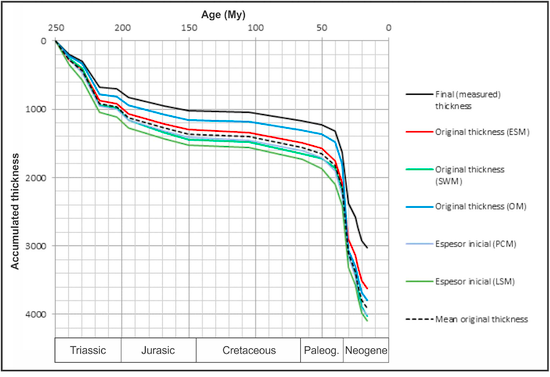Compactation in sedimentary basins
Subsidence analysis is an important technique in the study of sedimentary basins but the effects of compaction must be “backstripped”. The compaction of sediments is also of importance for petroleum and water reservoir research with very important economic derivations. Most methods for calculating compaction are based on empirically derived porosity-depth relationships from a variety of known sediment types. The challenge of this paper is to apply alternative methods for calculating compaction in sedimentary basins based on: physical calculation with elastic by Steinbrenner, oedometric and change of the specific weight of the sediment methods; and use of Loadcap software.
The Triassic to Lower Miocene 3025m thick succession of Sierra Espuña (SE Spain) is used as case study for the calculations. In this succession former mineralogical studies and apatite fission-track suggested an original thickness between 4 and 6km. The validity of each one of the proposed methods is discussed, as well as, compared for the whole succession compaction but also separately for hard vs soft sediments and for thick vs thin beds.

The compaction values obtained with the alternative methods are similar to those resulting with the lower-limit curves of the porosity-depth change method. The new methods have provided values slightly higher than 4km for the whole original thickness using the geotechnical software and the change of the sediments specific weigh methods; meanwhile values below 4km for other methods. So, in our opinion, the geotechnical software and the change of the specific weight of the sediment methods are compatible with mineralogical constraints and also, the input data are usually better known and easier to determinate. Otherwise, the elastic method seems only accurate for soft sediments; meanwhile the oedometric method is highly influenced by the thickness of the considered beds.
Latest Chattian-Langhian Volcano- Sedimentary Event
High amounts of Chattian-Langhian orogenic magmatism have generated volcaniclastic deposits that are interbedded within the penecontemporaneous sedimentary marine successions in several central-western peri-Mediterranean chains. These deposits are widespread in at least 41 units of different basins located in different geotectonic provinces: (1) the Africa-Adria continental margins (external units), (2) the basinal units resting on oceanic or thinned continental crust of the different branches of the western Tethys, (3) the European Margin (external units), and (4) the Western Sardinia zone (Sardinia Through units). The emplacement of volcaniclastic material in marine basins was controlled by gravity flows (mainly turbidites; epiclastites) and fallout (pyroclastites). A third type comprises volcaniclastic grains mixed with marine deposits (mixed pyroclastic-epiclastic). Calc-alkaline magmatic activity is characterized by a medium- to high-potassium andesite-dacite-rhyolite suite and is linked to complex geodynamic processes that affected the central-western Mediterranean area in the ∼26 to 15 My range. The space/time distribution of volcaniclastites, together with a paleogeographic reconstructions, provide keys and constraints for a better reconstruction of some geodynamic events. Previous models of the central-western Mediterranean area were examined to compare their compatibility with main paleotectonic and paleogeographic constraints presented by the main results of the study. Despite the complexity of the topic, a preliminary evolutionary model based on the distribution of volcaniclastites and active volcanic systems is proposed.

Recent Comments